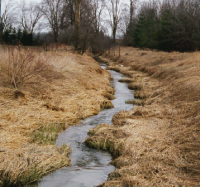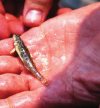
News
Farming and fish striking a balance
Farming and fish might be familiar
to those living on one of Canada’s coasts, but they are not on the same
page, so to speak in Ontario, are they?
October 7, 2008 By Top Crop Manager
Farming and fish might be familiar to those living on one of Canada’s coasts, but they are not on the same page, so to speak in Ontario, are they?
They are when it comes to the role of watercourses through farmland, and the vital part that farms play in areas such as sport fishing. Many landowners are unaware that the lake trout and walleye that are coveted by boating and fishing enthusiasts draw their sustenance from a food chain that originates in Ontario farming watersheds.
 |
| Watercourses do much more than just provide drainage for farmland, they represent a thriving ecosystem that feeds streams, rivers and lakes. |
The process of bridging that gap has fallen to fish habitat biologists like Joe de Laronde and Dana Boyter from the Department of Fisheries and Oceans (DFO) Canada. The two have been involved in workshops for drainage contractors since 2005 and have been working with municipalities since, and are now expanding that work to include landowners, particularly in 2008.
The take-home message from de Laronde and Boyter is simple: it may seem like a drain or a stream running through someone’s property, but it really is a thriving ecosystem with a variety of impacts that can be seen at various levels. And it is not as though the two stop at a farm with the intent of dictating terms and quoting chapter and verse from either the Drainage Act or the Fisheries Act. They want to promote the health of watercourses and find an equitable course of action, not become bogged down in confrontations.
The final outcome in their work benefits everyone and everything: fish habitat is improved as is the ecosystem moving up the food chain, including the health of streams, rivers and lakes. And with the improvement of the drains, the value of the land, both aesthetically and agronomically, increases.
According to Boyter, many land-owners are quite content to comply with their recommendations. “When we walked into the sessions in Ottawa, the results were good because most drains are connected to the Rideau River and we had young walleye in some of our samples. That’s a sport fish and something a lot of people go after, so that rang true with a lot of people at that workshop,” says Boyter, who works out of the Burlington DFO office. He adds that working proactively with
landowners can help make a connection through memories and reminiscences. “It may reconnect them with some of the anecdotal information and stories and memories that they have when they were kids. We get so many of these
stories, that when this particular grower was young, this waterway was full of trout, so this may reconnect these landowners with what they remember being in that watercourse or drain.”
So many positives
 |
| A johnny darter, just one of a number of small species of fish found in farm drains and streams, that feed larger species in the food chain of rivers and lakes. |
For de Laronde, the opportunity to work with DFO personnel should be anything but negative, which is why he cannot understand there being any reluctance to working with the federal ministry. “The workshop is all about minimizing the whole Drainage Act versus Fisheries Act type of discussion,” explains de Laronde, who is based in London. “From my perspective, I would expect the same types of results that we get out of drainage superintendents that we’re going to get from the farmers or the councillors or members of the public. All we’re saying is, ‘Here’s what we’re seeing, here’s what it relates to and what brings these fish species here, and what species they need to live’.”
The two cover the regulations that are attached to the process, and work to help those attending the workshops to understand the intent behind the respective Acts. For instance, although there is one Fisheries Act, there is a large number of agencies and authorities, including Environment Canada and local Conservation Authorities, that have the power to enforce the regulations. While it might be understandable that there are negative perceptions about ‘government involvement’, Boyter and de Laronde have found very little reluctance from participants at their presentations. “I’ve had a greater incidence of people asking about what else they can do,” offers de Laronde. “There are still some growers who just want to see a trough, but there are other incidents of greater enlightenment.”